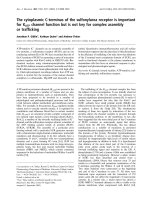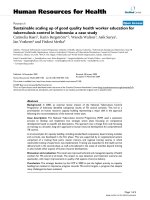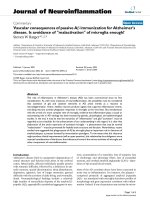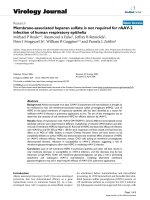passive case finding for tuberculosis is not enough
Bạn đang xem bản rút gọn của tài liệu. Xem và tải ngay bản đầy đủ của tài liệu tại đây (246.92 KB, 5 trang )
International Journal of Mycobacteriology
5 ( 2 0 1 6 ) 3 7 4 –3 7 8
Available at www.sciencedirect.com
ScienceDirect
journal homepage: www.elsevier.com/locate/IJMYCO
Review
Passive case finding for tuberculosis is not enough
Jennifer Ho a,b,c,*, Greg J Fox a,c,d, Ben J Marais c,d,e
a
Woolcock Institute of Medical Research, University of Sydney, Sydney, Australia
South Western Sydney Clinical School, University of New South Wales, Sydney, Australia
c
Centre for Research Excellence in Tuberculosis (TB-CRE) and the Marie Bashir Institute for Infectious Diseases and Biosecurity (MBI),
University of Sydney, Sydney, Australia
d
Sydney Medical School, University of Sydney, Sydney, Australia
e
The Children’s Hospital at Westmead, University of Sydney, Sydney, Australia
b
A R T I C L E I N F O
A B S T R A C T
Article history:
Current World Health Organisation targets calling for an end to the global tuberculosis (TB)
Received 8 September 2016
epidemic by 2035 require a dramatic improvement in current case-detection strategies. A
Accepted 21 September 2016
reliance on passive case finding (PCF) has resulted consistently, in over three million infec-
Available online 28 October 2016
tious TB cases per year, being missed by the health system, leading to ongoing transmission of infection within families and communities. Active case finding (ACF) for TB has
Keywords:
been recognized as an important complementary strategy to PCF, in order to diagnose
Active case finding
and treat patients earlier, reducing the period of infectiousness and therefore transmission.
Screening
ACF may also achieve substantial population-level TB control. Local TB epidemiology and
Diagnosis
the resources available in each setting will influence which populations should be
TB elimination
screened, and the types of ACF interventions to use for maximal impact. TB control pro-
End TB strategy
grams should begin with the highest risk groups and broaden their activities as resources
allow. Mathematical models can help to predict the population-level effects and the costeffectiveness of a variety of ACF strategies on different risk populations.
Ó 2016 Asian-African Society for Mycobacteriology. Production and hosting by Elsevier Ltd.
This is an open access article under the CC BY-NC-ND license ( />licenses/by-nc-nd/4.0/).
Contents
Introduction . . . . . . . . . . . . . . . . . . . . . . . . . . . . . . . . . . . . . . . . . . . . . . . . . . . . . . . . . . . . . . . . . . . . . . . . . . . . . . . . .
Active case finding versus passive case finding. . . . . . . . . . . . . . . . . . . . . . . . . . . . . . . . . . . . . . . . . . . . . . . . . . . . . .
Selecting a suitable population for screening: high yield target populations versus community-wide interventions
What active case finding approach is optimal? . . . . . . . . . . . . . . . . . . . . . . . . . . . . . . . . . . . . . . . . . . . . . . . . . . . . . .
Research gaps and priorities. . . . . . . . . . . . . . . . . . . . . . . . . . . . . . . . . . . . . . . . . . . . . . . . . . . . . . . . . . . . . . . . . . . . .
* Corresponding author at: Woolcock Institute of Medical Research, 431 Glebe Point Road, Glebe, NSW 2037, Australia.
E-mail address: (J. Ho).
Peer review under responsibility of Asian African Society for Mycobacteriology.
/>2212-5531/Ó 2016 Asian-African Society for Mycobacteriology. Production and hosting by Elsevier Ltd.
This is an open access article under the CC BY-NC-ND license ( />
.
.
.
.
.
.
.
.
.
.
.
.
.
.
.
375
375
376
377
377
International Journal of Mycobacteriology
5 ( 2 0 1 6 ) 3 7 4 –3 7 8
375
Conclusion . . . . . . . . . . . . . . . . . . . . . . . . . . . . . . . . . . . . . . . . . . . . . . . . . . . . . . . . . . . . . . . . . . . . . . . . . . . . . . . . . . . . . 377
Conflicts of interest . . . . . . . . . . . . . . . . . . . . . . . . . . . . . . . . . . . . . . . . . . . . . . . . . . . . . . . . . . . . . . . . . . . . . . . . . . . . . . 377
References. . . . . . . . . . . . . . . . . . . . . . . . . . . . . . . . . . . . . . . . . . . . . . . . . . . . . . . . . . . . . . . . . . . . . . . . . . . . . . . . . . . . . . 377
Introduction
Active case finding versus passive case finding
In the past two decades, the Directly Observed Treatment
Short-Course (DOTS) strategy and the subsequent Stop TB
(DOTS expansion) strategy, recommended by the World
Health Organisation (WHO), saved more than five million
lives [1]. However, total case numbers continue to rise and
tuberculosis (TB) remains the leading infectious cause of
death worldwide [2]. The WHO launched the End TB Strategy
in 2015 with the ambitious goal of ending the global TB epidemic [3]. Targets include a 90% reduction in TB incidence
and 95% reduction in TB deaths by 2035, compared to 2015.
‘‘Bending the epidemiological curve” of TB incidence and
mortality to meet these targets, will require improved case
detection to ensure early disease diagnosis, improve individual patient outcomes, and limit ongoing transmission.
In the majority of TB endemic settings worldwide, the status quo for TB case finding is based on ‘‘passive case finding”
(PCF). This relies upon a patient with active TB experiencing
symptoms serious enough to seek health care and a healthcare system capable of correctly diagnosing the patient’s condition. [4] However, this strategy, as shown consistently in
prevalence surveys [5,6], is grossly inadequate to detect the
substantial burden of undiagnosed TB in the community. It
is estimated that in 2014, more than 3.5 million people who
developed TB (one-third of all cases) were ‘‘missed” by the
health system [2]. This massive case detection gap culminates in late disease presentation, with poor disease outcomes, and undiagnosed infectious cases continuing to
spread infection within families and communities.
The term ‘‘active case finding” (ACF) includes any methods
for TB identification that does not rely on patients presenting
to the healthcare system of their own accord [7]. The objectives of ACF are to diagnose and treat patients earlier, thereby
reducing negative treatment outcomes, sequelae, and socioeconomic consequences, as well as reducing the period of
infectiousness and therefore transmission [4]. ACF has been
increasingly recognised as an important complementary
strategy to PCF in high-prevalence settings in order to overcome the gaps in TB detection and treatment. This need has
also been recognized by international donors, with initiatives
such as TB REACH established to support innovative
approaches to increasing TB case detection [8]. Although
two WHO guidelines, systematic screening [4] and household
contact investigations [9], provide some guidance to ACF in
resource limited settings, designing and implementing interventions that target the most appropriate populations, and
utilise feasible and cost-effective strategies, may be difficult
for national TB control programs (NTP) already struggling to
manage the existing burden of known disease.
In this review, we compare the additional individual and
population-level benefits of ACF with those of PCF, consider
pragmatic and economic factors relevant to ACF implementation in resource-limited settings, and highlight future
research needs and priorities.
The principle objective of ACF is to find and treat cases of
active TB that would otherwise not have been diagnosed at
this time, using strategies that are in keeping with available
resources. An important distinction between ACF and PCF is
that the former is a screening intervention initiated by health
services, as opposed to the latter, which is initiated by symptomatic individuals presenting to health-care. In general, ACF
activities are additive to PCF. Consequently, the diagnostic
algorithms and measures of success used in ACF may differ
from those used for PCF. The population targeted for ACF is
typically larger, and the prevalence of disease (or pretest probability) is lower. This results in a higher number needed to
screen, to diagnose one TB patient, compared to the PCF
context.
ACF for TB generally begins with an initial screening step
followed by confirmatory testing. Initial screening may comprise of one or a combination of symptom reporting or chest
radiography, and if either are positive, a confirmatory microbiological test, such as smear microscopy, or a molecular test
e.g. Xpert MTB/RIF [4]. Ideally, the confirmatory test should be
rapid, hence Mycobacterium tuberculosis (MTB) culture is a less
feasible option, unless the health system in place has sufficient capacity to follow-up screened patients [4].
However, the use of symptoms or chest X-ray as the initial
screening step has important limitations. Prevalence surveys
have shown consistently that the majority of undiagnosed TB
patients in the community lack typical symptoms of TB and a
large proportion have no symptoms at all [10–12]. Furthermore, while chest radiography is more sensitive than using
a symptom-based approach alone, this can be logistically difficult in many rural and remote settings. Xpert MTB/RIF used
up-front as a primary screening tool (i.e., regardless of symptoms reported or chest X-ray findings), has been shown to be
feasible and improve case detection in certain high risk populations, such as people living with HIV (PLHIV) [13,14], and
also in ACF conducted in the general community [15]. While
this approach may overcome some limitations of traditional
TB screening, the feasibility and cost-effectiveness of this
strategy in a programmatic setting is yet to be determined.
One argument against ACF it that it merely detects disease
earlier, but does not substantially alter individual patient outcomes. However, diagnosing and treating TB disease earlier is
likely to have a substantial impact on TB transmission,
decreasing the long term trajectory of TB in a population,
and subsequently reducing the cost of TB control overall
[16]. It is important however, when evaluating the
population-level effects and the cost-effectiveness of ACF, to
consider its impact over a longer time frame (e.g., a 20-year
time horizon), as short-term assessments can dramatically
underestimate longer- term gains of ACF [16]. Table 1 lists outcome measures that should be considered when evaluating
the benefit of ACF, as well as the other key characteristics of
ACF compared to PCF for TB.
376
International Journal of Mycobacteriology
5 ( 2 0 1 6 ) 3 7 4 –3 7 8
Table 1 – Characteristics of active compared to passive case finding for TB.
Characteristic
Considerations for active case finding
Population evaluated
Less reported symptoms
Earlier stage of disease
Lower bacillary (MTB) load
Reduced health seeking behaviour
May be less likely to accept and complete treatment
More health care access and socioeconomic factors to consider
Prevalence of disease
Usually lower
Screening algorithm
The primary screening tool used should be:
– Rapid and simple to perform
– Sensitive to detect low organism load/early disease
– Appropriate to the resources available
– Adapted for the specific context and relevant target populations
Overall case detection should identify:
– Infectious patients as early as possible
– Detect active TB before serious complications develop
– Maximize ‘‘value for money” with the available resources
Focus on the added value of ACF such as:
– Reduced morbidity and mortality (less advanced disease);
– May experience initial increase in TB incidence with enhanced detection
– Decreased time to treatment initiation
– Improved treatment outcomes
– Reduced TB transmission; measured as prevalence of TB infection in young children
– Reduced active TB; measured as TB disease prevalence in the community
Should incorporate population level effects and cost-effectiveness estimates using a
long-term time frame
Outcome measures
MTB = Mycobacterium tuberculosis; ACF = active case finding.
Selecting a suitable population for screening: high
yield target populations versus community-wide
interventions
Factors that influence the choice of which populations should
be targeted for ACF include: TB prevalence, TB risk (e.g.,
comorbidities and socioeconomic factors), accessibility,
acceptability (amongst individuals in the population and
health care workers), and the infrastructure and resources
available.
In the ‘‘systematic screening for active TB” guidelines, the
WHO strongly recommend ACF for PLHIV, household contacts
of active TB patients, and workers exposed to silica [4]. Conditional recommendations (based on expert opinion and dependent on local TB epidemiology and resource factors), are given
for other risk groups such as prisoners, those with untreated
fibrotic lesions on chest X-ray; those seeking health care and
selected risk groups where the TB prevalence is P0.1%; populations where the TB prevalence is P1%; or those with poor
access to health-care [4]. Clinical groups with a higher risk
of developing TB (and poorer treatment outcomes) that may
benefit from ACF include those who are underweight, malnourished, diabetic, have alcohol dependence, smoke, have
chronic renal failure, or immunosuppression [4,17]. Homeless
people, those living in slums, and other deprived communities generally have poorer access to health-care, a higher risk
of TB transmission in some settings, and may also benefit
greatly from ACF interventions [18–20].
Before the 1960s, mass chest radiography was the primary
form of ACF in many industrialized countries [21]. However, in
their ninth report in 1974, the WHO expert committee on
tuberculosis recommended that ‘‘the policy of indiscriminate
TB case-finding by mobile mass radiography should now be
abandoned”, citing evidence of the inefficiency, low yield,
and high cost of mass radiography [22]. Since this recommendation, screening of populations for TB generally has been
avoided, other than for selected high-risk groups. Instead,
high prevalence countries have been encouraged to focus their
resources on optimizing existing diagnostic and treatment
services. However, this narrow focus on selected high-risk
groups has been unable to reach the majority of undiagnosed
cases in the community and, despite substantial investment
in PCF, has only achieved a global decline in TB incidence of
2% per year [2]. This figure needs to increase to 10% per year
by 2025, to achieve TB elimination targets [3]. Therefore, it is
imperative that broader screening strategies that will achieve
the desired epidemiological impact are considered.
Few randomized trials that have assessed the effectiveness of ACF in a community-wide setting. Four randomized
controlled trials (RCTs) have been performed in Africa, with
mixed results. A cluster RCT conducted in Zimbabwe (the
DETECTB study) [23] evaluated an intervention of six rounds
of six monthly screening for adults with P2 weeks of cough,
to over 100,000 participants using either mobile vans or
door-to-door visits. The study found a decline in disease
prevalence from 6.5 to 3.7 per 1000 adults (risk ratio 0Á59,
95% CI 0Á40–0Á89, p = 0.0112) at the end of, compared to before,
the intervention. In contrast, a large community randomized
trial of active case-finding among almost 45,000 participants
in Zambia and the Western Cape of South Africa (the ZAM-
International Journal of Mycobacteriology
5 ( 2 0 1 6 ) 3 7 4 –3 7 8
377
STAR study), did not demonstrate a population-wide benefit
[24]. The study compared two enhanced case finding interventions: community mobilization and promotion of sputum
smear examination; and combined TB-HIV household-level
activities. Neither intervention led to a reduction in the community prevalence or incidence of TB [24]. While these two
trials yielded different effects on disease prevalence, the
actual interventions used in these two studies differed
considerably.
Two additional RCTs of community-wide ACF studies in
rural southern Ethiopia [25,26] implemented periodic education about TB symptoms, by community workers in peripheral health facilities, and encouraged symptomatic
individuals to seek health-care. One study found the intervention improved case detection rates, compared to passive
case finding [25], whereas the other found a reduction in time
to diagnosis, but not the extent of case finding for smear positive TB [26].
TB, remains unknown. We also do not know what strategies
are most effective in different settings, or, how frequently
and for how long ACF interventions need to be performed.
As the prevalence of disease decreases, ACF is likely to appear
less cost-effective (per case diagnosed) but will be important
to sustain long-term declines in incidence to achieve TB elimination targets.
Further operational and public health research with appropriate impact evaluation, together with mathematical and
economic modeling, will be greatly beneficial in answering
some of these questions. Careful monitoring and evaluation
of all current and future ACF activities is also essential. Better
screening tools will also facilitate up-scaling of ACF strategies. A sensitive, portable, low-cost, point-of-care test will
revolutionize TB screening, improving the efficiency, feasibility, and cost-effectiveness of all screening interventions.
What active case finding approach is optimal?
Current passive TB case finding approaches are insufficient to
meet ambitious TB elimination targets, especially in endemic
areas where the bulk of the ‘‘missing 3.5 million cases” reside
[2]. Until new breakthroughs in disease prevention occur, significant improvements in case detection will be essential if
the global TB epidemic is to be overcome. ACF interventions
are likely to be feasible in all settings, but the scale and focus
of these interventions will need to be contextualized and will
inevitably be limited by available resources. When designing
an ACF strategy, TB control programs should begin with easily
identifiable high-risk target groups and then widen their
scope of activities as resources allow. Further research is
imperative to determine the most feasible and cost-effective
ACF approaches in different settings.
ACF for TB is likely to be feasible to some degree in all settings; however, determining the most appropriate strategy
for each setting requires careful planning and consideration.
The most suitable approach will depend on the resources
available and the local TB epidemiology. NTPs should start
with a narrow focus (e.g., highest risk groups) and broaden
as resources allow. Baseline information required includes
high quality surveillance data such as prevalence rates, incidence rates, and transmission ‘hot spots’. Mathematical modelling can help predict the population level impact, costeffectiveness and optimal duration and frequency for specific
ACF interventions [16,27–29]. A web-based modeling tool,
developed by Nishikori [30], can be used to compare costeffectiveness parameters for different diagnostic algorithms
when applied to different risk populations [30].
Novel strategies involving community workers, volunteers, mobile phone technology, or the private sector to implement ACF activities [25,31], may improve the efficiency and
feasibility of ACF on a broader scale. Integrating ACF into
existing health-care services is also important to optimize
resources and achieve sustainability [32]. Adequate diagnostic
and treatment facilities, with the capacity for scale-up, are
crucial to avoid treatment delays and loss to follow-up. Lastly,
additional treatment support should be considered for
patients diagnosed via ACF, given that they may be minimally
symptomatic and their failure to initiate health care contact
may indicate reduced ‘‘readiness” for treatment. These
patients may also be burdened with socioeconomic factors
that make them more likely to fail to start, or be noncompliant with treatment [33,34].
Research gaps and priorities
While there is consensus on the effectiveness of ACF in certain high-risk groups such as PLHIV and household contacts
[4], major research gaps remain. Whether ACF leads to better
treatment outcomes, substantially reduces transmission, or
has a beneficial impact on the longer-term epidemiology of
Conclusion
Conflicts of interest
None to declare.
R E F E R E N C E S
[1] P. Glaziou et al, Lives saved by tuberculosis control and
prospects for achieving the 2015 global target for reducing
tuberculosis mortality, Bull. World Health Organ. 89 (2011)
573–582, />[2] World Health Organization, Global Tuberculosis Report 2015,
20th Edition.
[3] WHO End TB Strategy, < />strategy/en/> (2015).
[4] WHO, Systematic Screening for Active Tuberculosis. (2013).
[5] I. Onozaki et al, National tuberculosis prevalence surveys in
Asia, 1990–2012: an overview of results and lessons learned,
Trop. Med. Int. Health 20 (2015) 1128–1145, />10.1111/tmi.12534.
[6] Report FIRST National TB Prevalence Survey 2012, Nigeria.
[7] G.H. Bothamley, L, Ditiu, G.B. Migliori, C, Lange, contributors.
Active case finding of tuberculosis in Europe: a Tuberculosis
Network European Trials Group (TBNET) survey, Eur. Respir. J.
(32) (2008), 1023–1030. doi:10.1183/09031936.00011708.
[8] TB REACH, Stop TB Partnership,
378
International Journal of Mycobacteriology
[9] World Health Organization. Recommendations for
investigating contacts of persons with infectious tuberculosis
in low- and middle-income countries. (2012).
[10] Ministry of Health Cambodia, National Tuberculosis
Prevalence Survey Cambodia, 2002, Ministry of Health
Cambodia, Phnom Penh, 2005.
[11] S. den Boon et al, An evaluation of symptom and chest
radiographic screening in tuberculosis prevalence surveys,
Int. J. Tuberc. Lung Dis. 10 (2006) 876–882.
[12] N.B. Hoa et al, National survey of tuberculosis prevalence in
Viet Nam, Bull. World Health Organ. 88 (2010) 273–280, http://
dx.doi.org/10.2471/BLT.09.067801.
[13] T.T. Balcha et al, Intensified tuberculosis case-finding in HIVpositive adults managed at Ethiopian health centers:
diagnostic yield of Xpert MTB/RIF compared with smear
microscopy and liquid culture, PLoS One 9 (2014) e85478,
/>[14] H.A. Al-Darraji, H. Abd Razak, K.P. Ng, F.L. Altice, A.
Kamarulzaman, The diagnostic performance of a single
GeneXpert MTB/RIF assay in an intensified tuberculosis case
finding survey among HIV-infected prisoners in Malaysia,
PLoS One 8 (2013) e73717, />pone.0073717.
[15] J. Ho et al, Reassessment of the positive predictive value and
specificity of Xpert MTB/RIF: a diagnostic accuracy study in
the context of community-wide screening for tuberculosis,
Lancet Infect. Dis. (2016), />[16] A.S. Azman, J.E. Golub, D.W. Dowdy, How much is
tuberculosis screening worth? Estimating the value of active
case finding for tuberculosis in South Africa, China, and
India, BMC Med. 12 (2014) 216, />s12916-014-0216-0.
[17] B.J. Marais et al, Tuberculosis comorbidity with
communicable and non-communicable diseases: integrating
health services and control efforts, Lancet Infect. Dis. 13
(2013) 436–448, />70015-X.
[18] C.L. Ogbudebe et al, Reaching the underserved: active
tuberculosis case finding in urban slums in southeastern
Nigeria, Int. J. Mycobacteriol. 4 (2015) 18–24, />10.1016/j.ijmyco.2014.12.007.
[19] K. Kranzer et al, Feasibility, yield, and cost of active
tuberculosis case finding linked to a mobile HIV service in
Cape Town, South Africa: a cross-sectional study, PLoS Med. 9
(2012) e1001281, />pmed.1001281.
[20] N. Lorent et al, Community-based active tuberculosis case
finding in poor urban settlements of Phnom Penh, Cambodia:
a feasible and effective strategy, PLoS One 9 (2014) e92754,
/>[21] J.E. Golub, C.I. Mohan, G.W. Comstock, R.E. Chaisson, Active
case finding of tuberculosis: historical perspective and future
prospects, Int. J. Tuberc. Lung Dis. 9 (2005) 1183–1203.
[22] WHO Expert Committee on Tuberculosis: ninth report,.
Geneva, World Health Organization (16) 1974. (WHO
Technical Report Series, No. 552).
5 ( 2 0 1 6 ) 3 7 4 –3 7 8
[23] E.L. Corbett et al, Comparison of two active case-finding
strategies for community-based diagnosis of symptomatic
smear-positive tuberculosis and control of infectious
tuberculosis in Harare, Zimbabwe (DETECTB): a clusterrandomised trial, Lancet 376 (2010) 1244–1253, .
org/10.1016/S0140-6736(10)61425-0.
[24] H. Ayles et al, Effect of household and community
interventions on the burden of tuberculosis in southern
Africa: the ZAMSTAR community-randomised trial, Lancet
382 (2013) 1183–1194, />61131-9.
[25] D.G. Datiko, B. Lindtjorn, Health extension workers improve
tuberculosis case detection and treatment success in
southern Ethiopia: a community randomized trial, PLoS One
4 (2009) e5443, />pone.0005443.
[26] E.B. Shargie, O. Morkve, B. Lindtjorn, Tuberculosis casefinding through a village outreach programme in a rural
setting in southern Ethiopia: community randomized trial,
Bull. World Health Organ. 84 (2006) 112–119. doi:/S004296862006000200011.
[27] P. Kasaie, J.R. Andrews, W.D. Kelton, D.W. Dowdy, Timing of
tuberculosis transmission and the impact of household
contact tracing. An agent-based simulation model, Am. J.
Respir. Crit. Care Med. 189 (2014) 845–852, />10.1164/rccm.201310-1846OC.
[28] P.J. Dodd, R.G. White, E.L. Corbett, Periodic active case finding
for TB: when to look?, PLoS ONE 6 (2011) e29130, http://dxdoi.
org/10.1371/journal.pone.0029130.
[29] D.W. Dowdy et al, Population-level impact of active
tuberculosis case finding in an Asian megacity, PLoS One 8
(2013) e77517, />pone.0077517.
[30] N. Nishikiori, C. Van Weezenbeek, Target prioritization and
strategy selection for active case-finding of pulmonary
tuberculosis: a tool to support country-level project planning,
BMC Public Health 13 (2013) 97, />1471-2458-13-97.
[31] A.J. Khan et al, Engaging the private sector to increase
tuberculosis case detection: an impact evaluation study,
Lancet Infect. Dis 12 (2012) 608–616, />s1473-3099(12)70116-0.
[32] C.M. Yuen et al, Turning off the tap: stopping tuberculosis
transmission through active case-finding and prompt
effective treatment, Lancet 386 (2015) 2334–2343, http://dx.
doi.org/10.1016/s0140-6736(15)00322-0.
[33] P.G. Gopi, V. Chandrasekaran, R. Subramani, P.R. Narayanan,
Failure to initiate treatment for tuberculosis patients
diagnosed in a community survey and at health facilities
under a DOTS programme in a district of South India, Indian
J. Tuberc. 52 (2005) 153–156.
[34] J.E. Golub, D.W. Dowdy, Screening for active tuberculosis:
methodological challenges in implementation and
evaluation, Int. J. Tuberc. Lung Dis. 17856–65 (2013) 2013,
/>
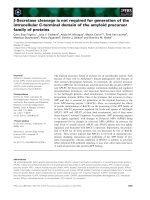
![[Henry kellerman] love is not enough what it takes to make it work (2009)](https://media.store123doc.com/images/document/14/rc/ix/medium_PGcSaml95b.jpg)

